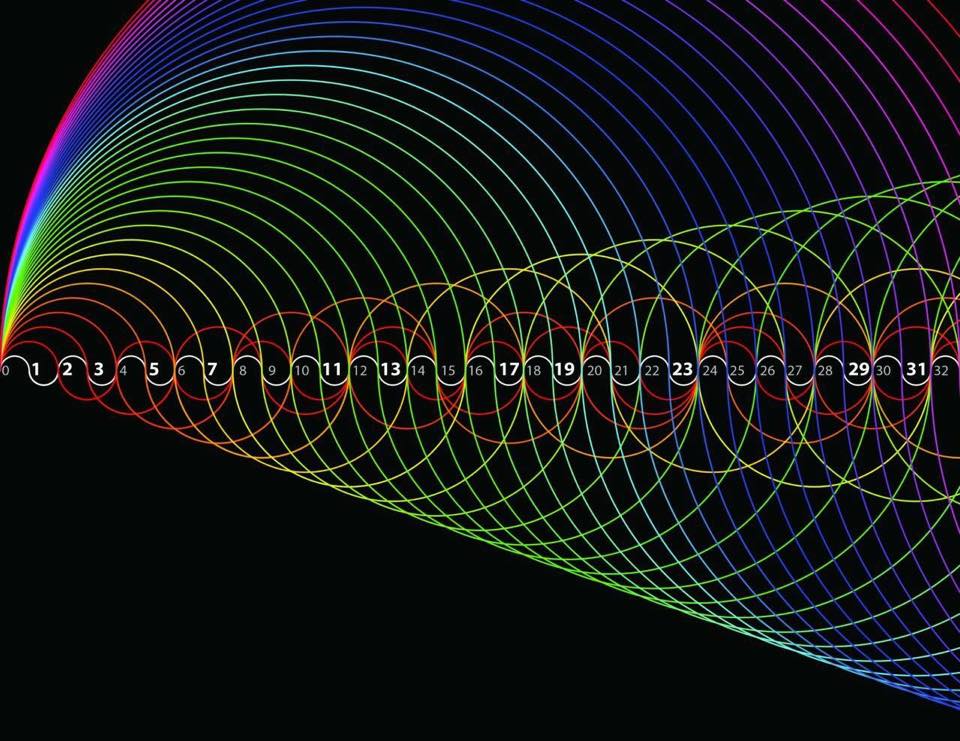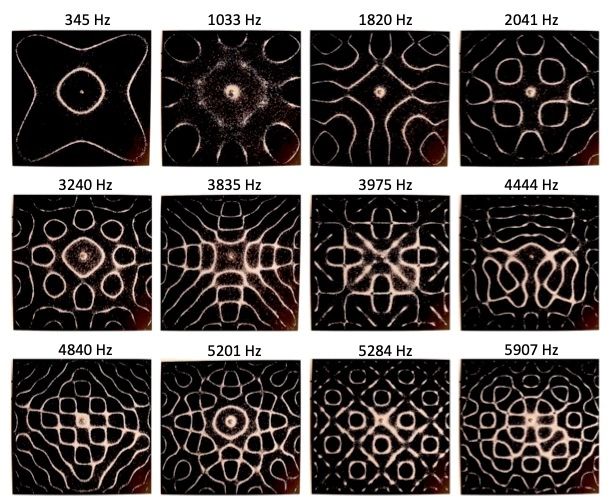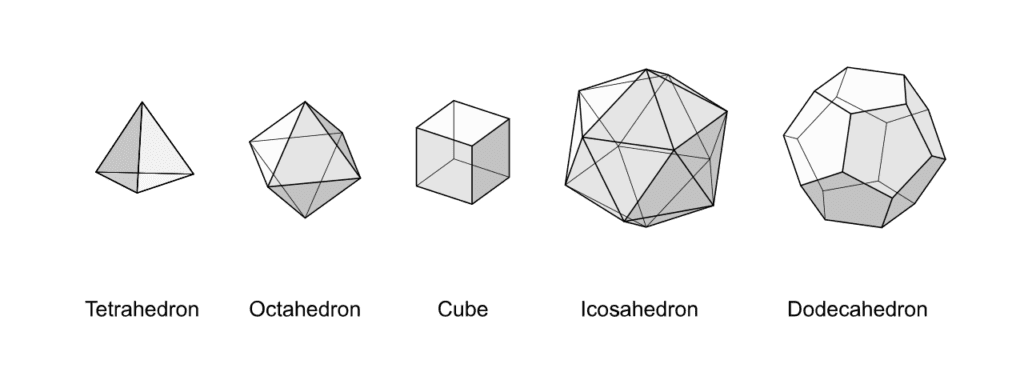
The Hidden Harmonics of the Universe and the Geometry of Sound
Throughout history, mystics, mathematicians, and musicians have been captivated by the intricate relationship between sound and form. From Pythagoras's discovery of harmonic ratios to modern experiments in cymatics, we discover that sound not only moves through space, but creates it, giving rise to geometric patterns that underlie the structure of our reality.
At the Legatto Institute, we explore these profound connections between Sacred Geometry and Musical Alchemy, revealing how harmonics shape both the visible and invisible worlds.
The Geometry of Sound: Vibrations in Form
Imagine dropping a stone into a still pond. Ripples expand outward in perfect concentric circles. This is a simple example of how vibration gives rise to form. In music, something similar happens: every sound wave creates geometrically precise patterns, whether in the air, on the surface of a liquid, or even in our own cells.
A pioneering field called cymatics demonstrates this visually. By placing fine sand or water on a vibrating plate, the material arranges itself into beautiful symmetrical shapes, each corresponding to a specific frequency. These shapes aren't random; they reflect the fundamental patterns of nature, from the spirals of galaxies to the petals of a flower.

What exactly are harmonics in sound and other physical phenomena?
Harmonics are the natural overtones (additional, higher-frequency vibrations) that accompany a fundamental sound. When a string vibrates, for example, it not only produces a single tone, but also generates a series of higher frequencies that follow a mathematical pattern.
Each musical note is not a single frequency, but a combination of multiple frequencies.: What we perceive as the fundamental frequency (the lowest, most dominant pitch) is accompanied by a series of higher-frequency vibrations called harmonics or overtones. These harmonics follow a precise mathematical pattern and typically occur in whole-number multiples of the fundamental frequency (for example, if the fundamental frequency is 100 Hz, its harmonics will be 200 Hz, 300 Hz, 400 Hz, etc.). These harmonic frequencies shape the timbre of an instrument or voice, giving each sound its unique color and resonance.
In the physical world, harmonics occur in various forms. Ocean waves, planetary orbits, and even electromagnetic frequencies exhibit harmonic structures. In light waves, different colors correspond to specific harmonic frequencies of electromagnetic radiation. In ocean waves, harmonics determine how energy propagates across the water's surface. Even in human biology, our heartbeats, brain waves, and the rhythmic cycles of sleep and consciousness operate in harmonic patterns.
This suggests that harmonics are not unique to music, but a fundamental property of the universe, acting as a bridge between sound, mathematics, and the structure of reality itself.Recognizing these patterns allows us to tune into the natural resonance of our environment, fostering both inner and outer harmony.

Sacred Geometry in Musical Scales
Sacred Geometry is the study of the patterns and proportions that make up the fundamental structure of the universe. It reveals a deep, underlying order in nature, from the spirals of galaxies to the arrangement of flower petals. Music, as a vibrational expression of this order, follows the same universal principles. The harmonic proportions in sound are not random, but are encoded in the very geometry of reality.
Pythagoras and the Harmonic Model
Pythagoras, the ancient philosopher and mathematician, was one of the first to link musical harmony with mathematical ratios. He discovered that when a vibrating string is divided into simple ratios, such as 1:2 (the octave), 2:3 (the perfect fifth), and 3:4 (the perfect fourth), the resulting notes combine in a naturally pleasing way. This gave rise to what we now call the harmonic series, the fundamental structure of musical scales.
Pythagoras's discoveries transcended the realm of music. He believed that the entire cosmos was structured by these same harmonic relationships, a concept later known as the "Music of the Spheres." According to this idea, celestial bodies move in proportional ratios, creating an inaudible but omnipresent cosmic symphony.
But Pythagorean harmonics are just the beginning. The relationship between geometry, frequency, and vibration is even deeper when we examine the Platonic solids, the five fundamental geometric shapes that underlie the structure of all existence.
Platonic solids and musical proportions
The five Platonic solids (the tetrahedron, the hexahedron (cube), the octahedron, the dodecahedron, and the icosahedron) are the basic building blocks of matter. These geometric shapes appear in natural formations such as crystals, atomic structures, and even biological organisms. Fascinatingly, these same shapes encode the frequency relationships present in music.
1. The Cube (Hexahedron) – The Perfect Fourth (Proportion 4:3)
The cube, with its square faces and 90-degree angles, represents stability and fundamental structure. The 4:3 ratio, which defines the perfect fourth in music, reflects this principle of stability. In harmonic theory, the perfect fourth acts as a solid, fundamental interval, similar to the cube in geometry.
2. The Tetrahedron – The Fifth Just (Proportion 3:2)
The tetrahedron, the simplest three-dimensional figure, is related to the perfect fifth (ratio 3:2). This interval is the most fundamental in harmony after the octave, often considered the "most consonant" sound in Western music. The tetrahedron's triangular symmetry represents balance and dynamic movement, qualities also reflected in the musical stability of the perfect fifth.
3. The Octahedron – The Major Third (Ratio 5:4)
The octahedron, formed by two interlocking tetrahedrons, resonates with the ratio 5:4, producing the major third, a bright and stimulating musical interval. This shape represents duality and expansion, similar to how the major third introduces harmonic warmth into music.
4. The Dodecahedron – The Harmonious Universe
The dodecahedron, with its 12 faces, is often associated with higher-dimensional resonance and the sacred nature of Phi (1.618). The dodecahedron structure is linked to the pentagon and the Golden Ratio, both of which play a role in certain musical tuning systems beyond standard Western scales. Some theorists suggest that the dodecahedron represents the "container" for harmonic frequencies, as considered in cosmology as a model of the universe itself.
5. The icosahedron – Harmonics of water and fluids
The icosahedron, with its 20 triangular faces, regulates fluidity and resonance. This shape appears in water molecules, and since sound travels through water faster than air, the icosahedron bridges the gap between geometric structure and vibrational flow. Some experimental tuning systems explore the relationships between icosahedral symmetry and harmonics in natural harmonic series.

How harmonics influence reality
Sound as a creative force
In many ancient traditions, sound was considered the primary force of creation. Vedic texts speak of “Nada Brahma” (the universe as sound), while the Bible states, “In the beginning was the Word.” Today, quantum physics aligns with this idea, suggesting that everything is vibrating energy and that vibration creates structure.
When we listen to harmonically rich sounds, such as overtone singing or carefully tuned instruments, our bodies and minds begin to resonate with these higher patterns. That is why it is said that certain frequencies, such as Solfeggio frequencies, have profound effects on consciousness and well-being..
The healing power of harmonics
Modern sound therapy uses specific geometric frequencies to promote healing and balance. Some key examples include:
- Binaural beats:Two slightly different frequencies, played in each ear, create a “phantom” frequency that influences brain wave states.
- Harmonic SingingMonks and shamans have used overtone singing for centuries to induce meditative states.
- Resonant Sound ChambersSacred architecture, such as Egyptian temples and Gothic cathedrals, was designed to amplify the harmonics that transform human consciousness.
Connecting the Ancient with the Modern
Today, a new generation of musicians, scientists, and artists is rediscovering these hidden harmonics to create immersive experiences that elevate human consciousness. Whether through microtonal tuning systems, holographic soundscapes, or harmonic resonance technology, we are beginning to tap into the deeper power of sound in ways that ancient wisdom traditions have long understood.
At the Legatto Institute, we explore these ideas through our Musical Alchemy sessions, where sound and form converge to expand perception. By learning to hear, see, and feel harmonics, we open the door to a more interconnected and harmonious world.
Final reflection: Listen beyond the ears
The next time you hear a sound, imagine its invisible geometry. Whether it's a simple note or a complex harmony, it's shaping the world around you in ways far deeper than you imagine.
Would you like to explore any of these ideas in more depth in future posts? Perhaps exploring specific tuning systems, cymatic experiments, or the role of harmony in ancient architecture?
